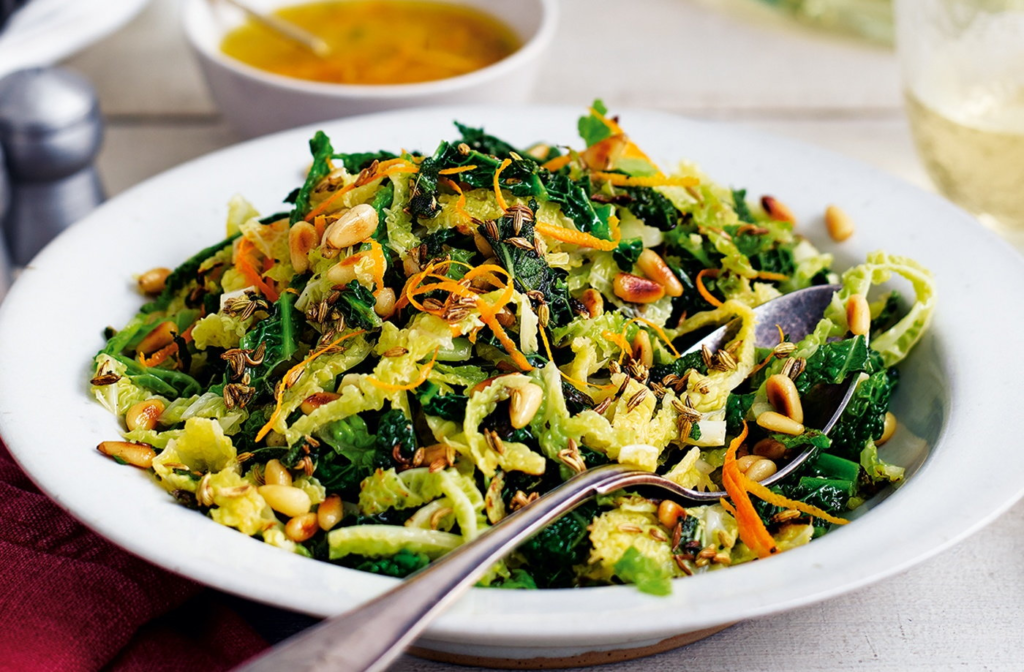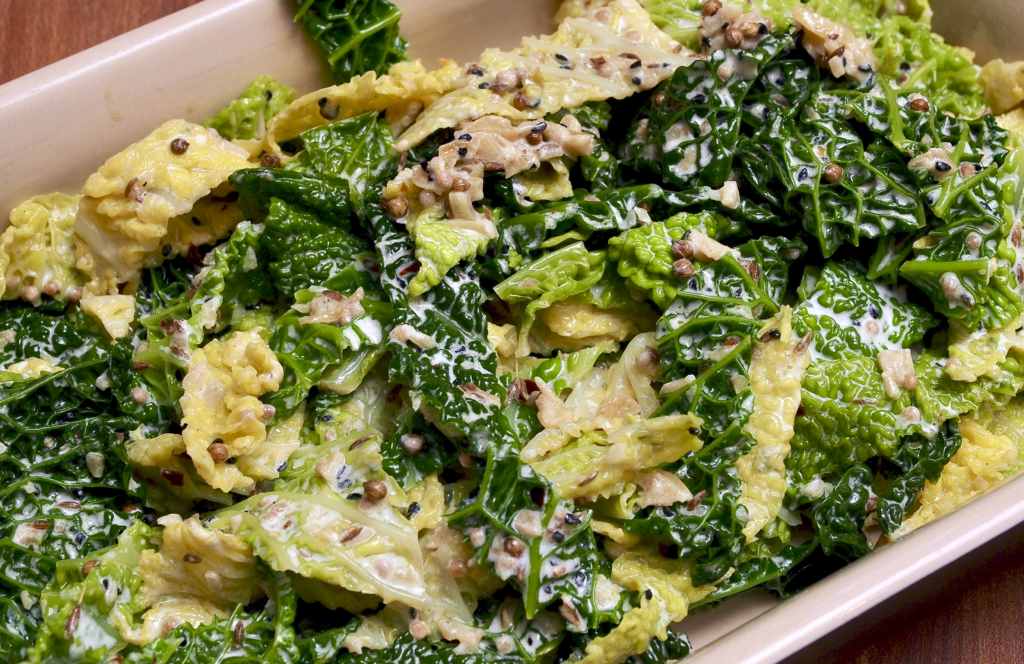How to Cook Savoy Cabbage: Easy & Delicious Tips
How to Cook Savoy Cabbage: Savoy cabbage is a great choice for home cooks. It’s full of flavor and nutrients. This guide will show you how to make it a staple in your kitchen. You’ll learn easy and tasty ways to cook savoy cabbage perfectly.

Focus on the texture of the savoy cabbage leaves, showing their crinkled and ruffled appearance. Use light and shadow to highlight the depth and dimensionality of the cabbage. Show a few outer leaves curling outward, as if inviting the viewer to peel them back and discover the tender interior.
Key Takeaways
- Savoy cabbage is a unique and nutrient-rich variety of cabbage with a distinctive texture and flavor.
- Savoy cabbage can be prepared in a variety of ways, from sautéing and roasting to braising and pickling.
- Choosing the right cooking method can bring out the best in savoy cabbage, enhancing its natural sweetness and tender texture.
- Savoy cabbage is a versatile ingredient that can be incorporated into a wide range of dishes, from hearty stews to light and refreshing salads.
- With the right techniques and recipes, savoy cabbage can be a delicious and healthy addition to any meal.
Savory Savoy Cabbage: A Nutrient-Rich Delight
Savoy cabbage is a special type of cabbage with tightly-packed leaves and a delicate texture. It has a unique, earthy taste and a tender feel when cooked right.
What Makes Savoy Cabbage Unique?
Its leaves are crinkly and ruffled, making it stand out. This texture also makes it taste sweeter and more delicate than other cabbages. Savoy cabbage is tender and easy to cook with.
Nutritional Benefits of Savoy Cabbage
Savoy cabbage is not just tasty but also packed with nutrients. It’s full of vitamin C, vitamin K, and folate, and has lots of fiber, manganese, and potassium. Eating it can help with digestion, boost the immune system, and lower inflammation.
Learn More Recipe: How to Cook Hake
| Nutrient | Amount per 1 cup (89g) serving | % Daily Value |
|---|---|---|
| Calories | 28 | 1% |
| Total Carbohydrates | 6g | 2% |
| Dietary Fiber | 3g | 11% |
| Vitamin C | 51mg | 85% |
| Vitamin K | 63µg | 79% |
| Folate | 58µg | 15% |
Savoy cabbage is a great addition to a healthy diet. It’s tasty, has a unique texture, and is full of nutrients.
How to Cook Savoy Cabbage: Step-by-Step Guide
Savory savoy cabbage is a versatile and nutrient-rich vegetable. It deserves a spot in your kitchen. Whether you’re sautéing, steaming, or roasting it, learning the right techniques can make your dishes better. Let’s dive into the step-by-step guide to cooking savoy cabbage perfectly.
Selecting and Preparing Savoy Cabbage
Choosing the freshest, most vibrant heads of savoy cabbage is the first step. Look for cabbages with tightly packed, curly leaves and a firm feel. Avoid any signs of wilting or discoloration. Once you’ve picked your cabbage, it’s time to prep it for cooking.
- Rinse the cabbage under cool water to remove any dirt or debris.
- Peel off the outermost leaves, revealing the tender, inner leaves.
- Cut the cabbage in half, then slice it into thin strips or shreds, depending on your desired texture.
- If the core is particularly tough, you can remove it before slicing the cabbage.
Cooking Methods for Savoy Cabbage
Now that your savoy cabbage is prepped, it’s time to choose the cooking method that best suits your recipe and preferences. Here are a few popular options:
- Sautéing: Heat a small amount of oil or butter in a skillet over medium-high heat. Add the sliced savoy cabbage and sauté, stirring occasionally, until it’s tender and slightly caramelized.
- Steaming: Place the shredded savoy cabbage in a steamer basket over a pot of simmering water. Cover and steam until the cabbage is tender but still has a slight bite.
- Roasting: Toss the savoy cabbage strips with olive oil, salt, and pepper, then spread them out on a baking sheet. Roast at 400°F (200°C) until the edges are crispy and the cabbage is fork-tender.
No matter which cooking method you choose, be sure to taste the savoy cabbage as it cooks and adjust the seasoning as needed. With a little practice, you’ll be a savoy cabbage cooking pro in no time!

Show the stages of cooking Savoy cabbage, starting with a whole head of cabbage and ending with a beautifully plated dish. Use vibrant colors and textured brushstrokes to convey the different cooking techniques such as blanching, sautéing, or roasting. Show each step in a circular motion to create a sense of movement and energy in the image. Focus on the visual appeal of the Savoy cabbage, highlighting its unique texture and flavor.
Learn More Recipe: How to Cook Carbonara
Mouthwatering Savoy Cabbage Recipes to Try
Savoy cabbage is a versatile ingredient that can be turned into many tasty dishes. From classic recipes to creative twists, these ideas will show you how to use this nutrient-rich vegetable in new ways.
Classic Savoy Cabbage Dishes
Enjoy the timeless flavors of savoy cabbage with these traditional recipes:
- Savoy Cabbage Rolls: Tender leaves wrapped around a savory filling, simmered in a rich tomato sauce.
- Sautéed Savoy Cabbage: Shredded savoy cabbage sautéed with garlic, onions, and a touch of butter for a simple yet flavorful side dish.
- Savoy Cabbage Soup: A hearty and comforting soup featuring savoy cabbage, potatoes, and aromatic herbs.
Creative Savoy Cabbage Twists
Try new ways to enjoy savoy cabbage with these innovative recipe ideas:
- Savoy Cabbage Gratin: Layers of savoy cabbage, cheese, and breadcrumbs, baked until golden and bubbly.
- Savoy Cabbage Slaw: Shredded savoy cabbage tossed with a tangy vinaigrette, crunchy vegetables, and fresh herbs.
- Savoy Cabbage Risotto: Creamy risotto made with savoy cabbage, mushrooms, and parmesan cheese.
Whether you want a classic dish or something new, these savoy cabbage recipes will delight your taste buds. They’ll inspire your next mealtime masterpiece.

A close-up of a pan filled with sizzling pieces of savory bacon and garlic. Savoy cabbage leaves are cut into ribbons and added to the pan, turning bright green as they cook. Steam rises from the pan as the flavors meld together. A sprinkle of salt and pepper completes the dish, ready to be served on a white plate.
Conclusion
We’ve taken a journey through the world of savoy cabbage, discovering its unique traits and health benefits. This leafy green is not just tasty but also packed with vitamins and minerals. It’s a great choice for anyone looking to eat healthier.
This guide has shown you how to prepare and cook savoy cabbage. You now have the skills to add this vegetable to your meals. Whether you like traditional dishes or something new, there are plenty of recipes and techniques to try.
Remember, savoy cabbage is special because of its texture and nutrition. Use it to make your meals more flavorful and healthy. Let this guide help you explore savoy cabbage and improve your cooking skills.
Learn More Recipe: How to Cook Stew
FAQ
What is savoy cabbage?
Savoy cabbage belongs to the Brassica family. It’s known for its unique, tightly-packed leaves and delicate texture. When cooked, it has a more earthy flavor and a tender, creamy feel.
What are the nutritional benefits of savoy cabbage?
Savoy cabbage is packed with vitamins, minerals, and antioxidants. It’s a great source of fiber, vitamins C, K, and B6, folate, and manganese. These nutrients can boost your health and well-being.
How do I select and store fresh savoy cabbage?
Choose savoy cabbage with bright, vibrant leaves and no blemishes. Keep it in the fridge, wrapped in a damp paper towel or plastic bag, for up to 1 week.
What are some common methods for cooking savoy cabbage?
You can cook savoy cabbage by sautéing, steaming, roasting, braising, or adding it to soups and stews. Always cook it gently to keep its tender texture and avoid overcooking.
Can savoy cabbage be used in both sweet and savory dishes?
Yes, savoy cabbage is versatile for both sweet and savory dishes. It can be used in classic recipes like cabbage rolls or sautéed as a side. It also works well in creative dishes like gratin or slaw.
How can I maximize the flavor and texture of savoy cabbage?
To enhance savoy cabbage, handle it carefully during prep and cooking. Trim the core, slice the leaves thinly, and season with flavors that complement it. This will bring out its natural sweetness and texture.
Is savoy cabbage a good option for those following a plant-based diet?
Yes, savoy cabbage is great for plant-based diets. It’s low in calories, high in fiber and nutrients, and can be made into many tasty dishes. It suits various dietary preferences.
Learn More Recipe: How to Cook Porridge